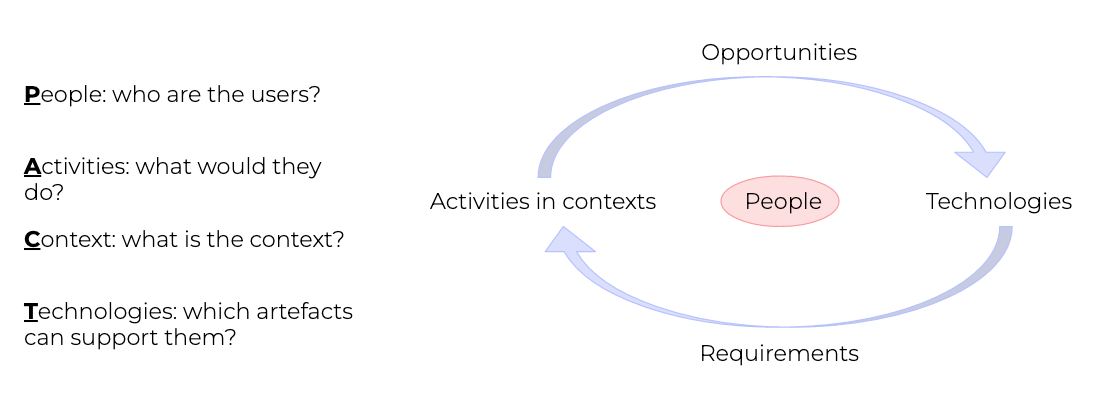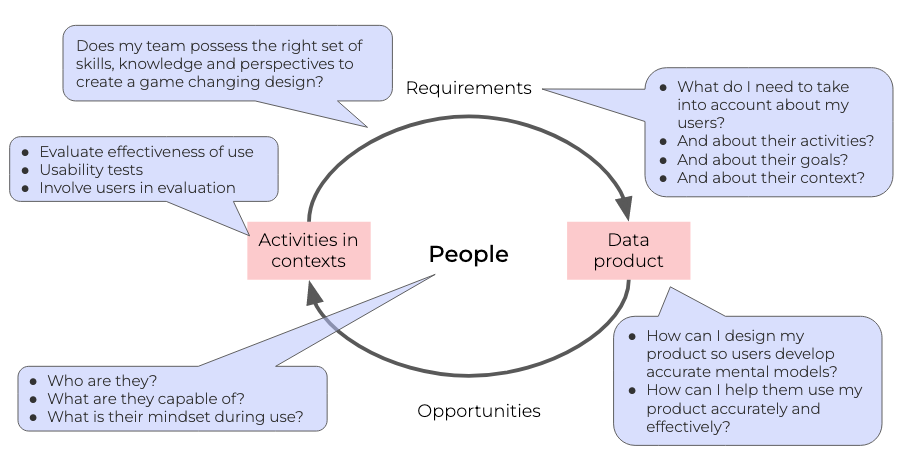
Impact and value through AI technology
AI products that work for you and with you
Improve your AI product's
quality
transparency
explainability
compliance
adoption
value
trustworthiness
fairness
quality
January 23, 2022
In the past two blogs I described:
Today's blog is the third and last in this series. It aims to dive a little deeper into the user research you might want to engage in to succeed in developing user-friendly, value-creating, impactful AI products.

Whatever product you are developing, a user-centered design is based on a rigorous understanding of how the intended users will be performing their tasks within a certain context. And how your product will help them do a better job at it.
Because of this focus, it is important that users are involved in the design process from the very beginning. Involving users does not mean you invite them to your sprint reviews every once in a while. Involving users means taking an interest in who they are, what they are doing, and why. And inviting them to use your product as they will when your product is released, and watch how they do this, what goes well or as expected, and what goes wrong or not as expected.
Don’t just interview them and take their word for it. Even if they try to explain themselves as best as they can - they will, for example, fail to mention things obvious to them but not to you. Or they will skip over parts of their job or their environment they are themselves unaware of.
A doctor, for instance, may fail to mention that there are constantly beeping machines around him, so adding another sound alert to their environment may not be as distinctive as you might think. Or a pharmacist may fail to mention they are not working on one laptop but on two different ones, moving back and forth between the two for her tasks. Or a data engineer may fail to tell you she is working in multiple product teams simultaneously.
Instead of interviewing your target group, try to find ways to observe what they are actually doing by visiting them in their setting. If you can, try following them around for some time. Ask them to perform their tasks while you observe them. Ask them what they are doing and why they are doing it, ask them to think aloud, so you can understand their reasoning and what they are trying to achieve. Pay attention to their surroundings and context: what tools or technology are they using, are they constantly in the same location or do they move around a lot? This can be a physical environment, but also a virtual environment where they navigate between screens or programs.
Ask yourself: At which points in their activities do they run into problems or hurdles? How could these obstacles be overcome with an newly envisioned AI product? At what times / moments / steps in their process do they face the problem you are trying to solve for them? In what stage of their activities or thought process are they at that time? What is their context? Are they alone or in a meeting with other people? Are they deeply focused or constantly switching between tasks? How can you tap into the state of mind they are in at the time they use your product?
This curiosity: understanding your user, who they are, what they need, what they know, what they are thinking, what they are doing. That is user-centred design.
And yes, there are all kinds of methods to work with, like creating personas and storyboards, or performing task analyses and contextual inquiries, and card sorting or think aloud procedures. And if you want to know more about them, please check the references at the end, or get in touch with me. Or maybe, I'll write another blog that taps into some of these methods. But first, everything starts with a curiosity for who your user is. From there, questions will arise about how to understand them better, and -depending on the question- you can find methods and tools that help you find answers to those questions.
Now that we have a better understanding of what user-centered design actually is, I want to go into the types of products designed by AI teams.
We can roughly classify data products into categories, based on their function and their interaction*.
When we look at function, i.e. "what content is the user consuming?", we can distinguish between:
Looking at form, i.e. "In what way is the content received by the user?", we can roughly distinguish between:
This heatmap shows how common we find certain combinations of form and function. For example, raw data is often used by people who are capable of processing that data themselves, and will therefore often receive that data through a more technical interaction such as an API. Whereas less technical people will often receive more processed information which they then receive through either dashboards or web elements, both of which have a graphical user interface.
For each of these products, combining form and function, you might ask yourself:

User-centered design is based on a few fundamental principles that are applied to the design process:
A user-centred design is based on a rigorous understanding of how the intended users will be performing their tasks within a certain context.
It’s important that users (and other stakeholders) are actively involved in the design process from the very beginning, all throughout the design process. You want to know all there is to know about how they will use your product, and what is needed to help them do so easily, responsibly, and effectively.
By knowing your user, you are better able to specify and clarify your design requirements:
How can the design tap into the mental models your users already have, and where can your design help them recognize how to use the product correctly.
I cannot overemphasize the importance of a user feedback loop in the product life cycle. The product team collects and analyzes feedback from users regularly. This information helps the team to make more user-focused decisions. Critical design decisions are evaluated based on how they work for end-users. And the resulting user feedback is incorporated to define requirements and design.
There should be no guessing or personal opinions - every design decision should be implemented based on the information you have about your users and validated during evaluations.
And like agile development, this is an iterative design process. The product team constantly works on improving value, usability, trust, and so on for the user; it introduces changes and refinements gradually as it gains more understanding about their target user group.
Ask yourself: Does my team possess the right set of skills, knowledge and perspectives to create a game changing design?
Our world is changing constantly, and so are our users, their activities, and the environments in which they live and work. In fact, our data products contribute to that change itself by creating new opportunities, allowing people to develop new ideas, needs, and activities. New requirements arise precisely because of our data products. So we are never done.
The key takeaway message of this blog series was:
A data solution doesn’t have to be perfect. It should be valuable, usable, trustworthy, and adoptable for the user. If it serves its user in doing a better job in a comfortable manner, it is already creating business value. It’s not (just) about optimizing model performance, it’s about optimizing the performance of the system that surrounds it. User-centred design focuses on the user: How can your product help your user do a better job?